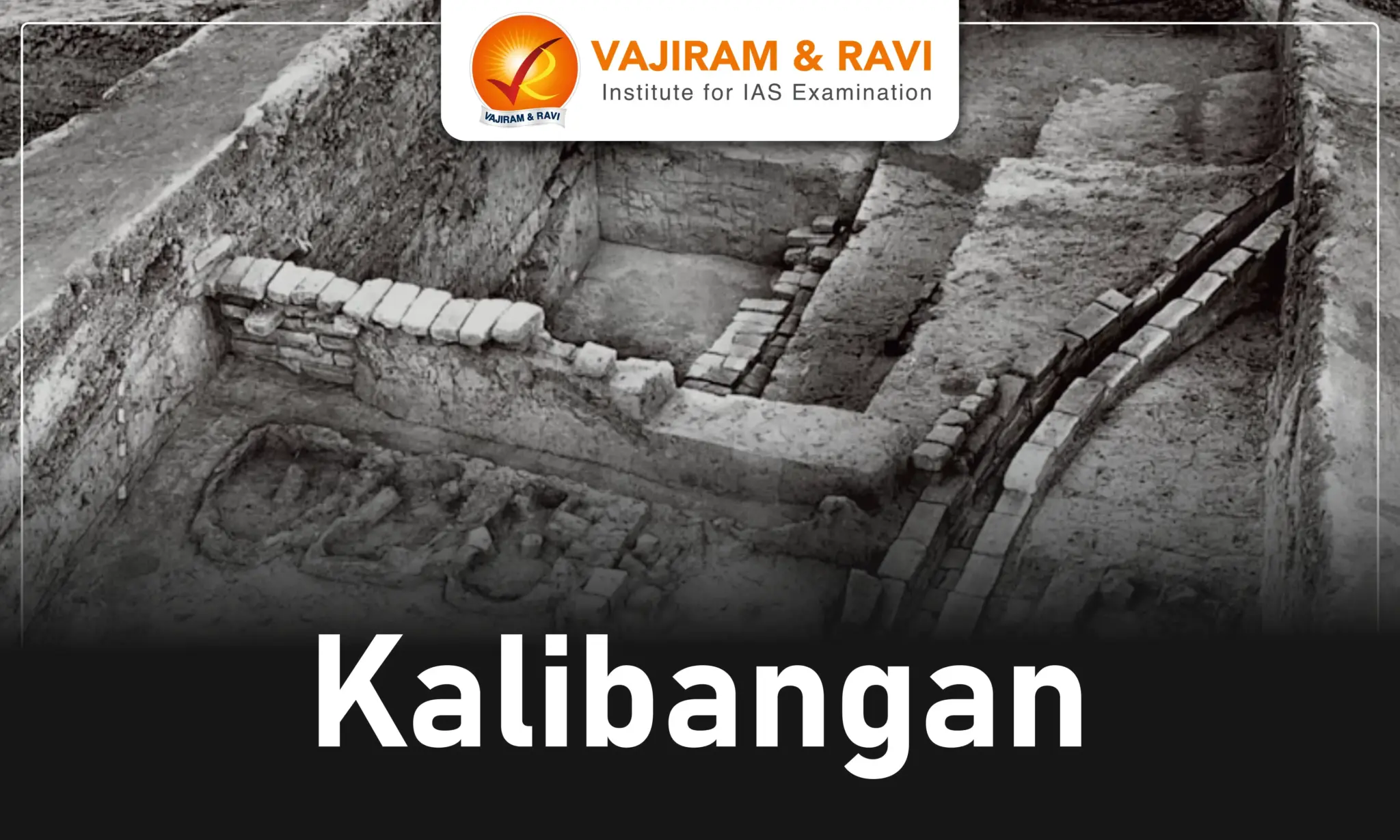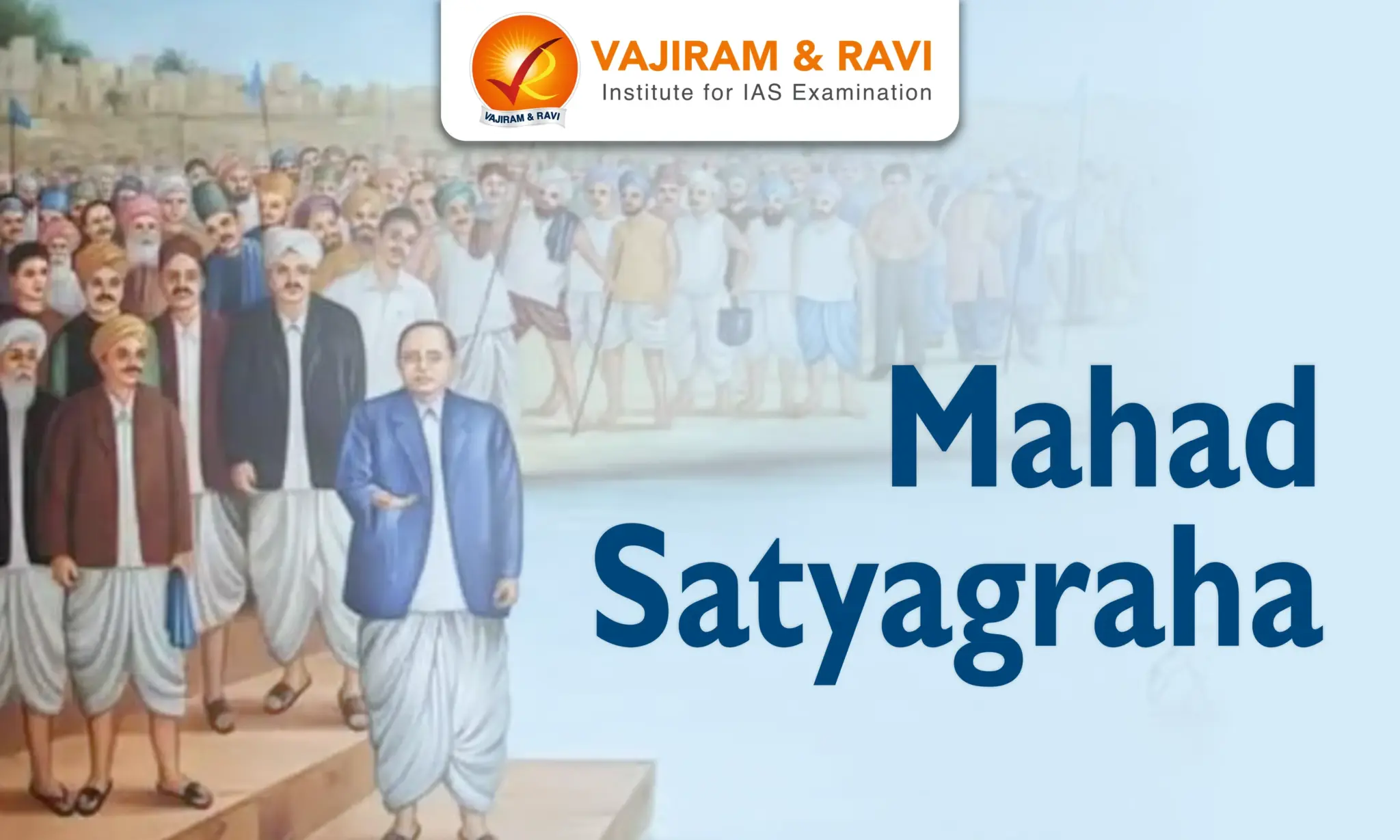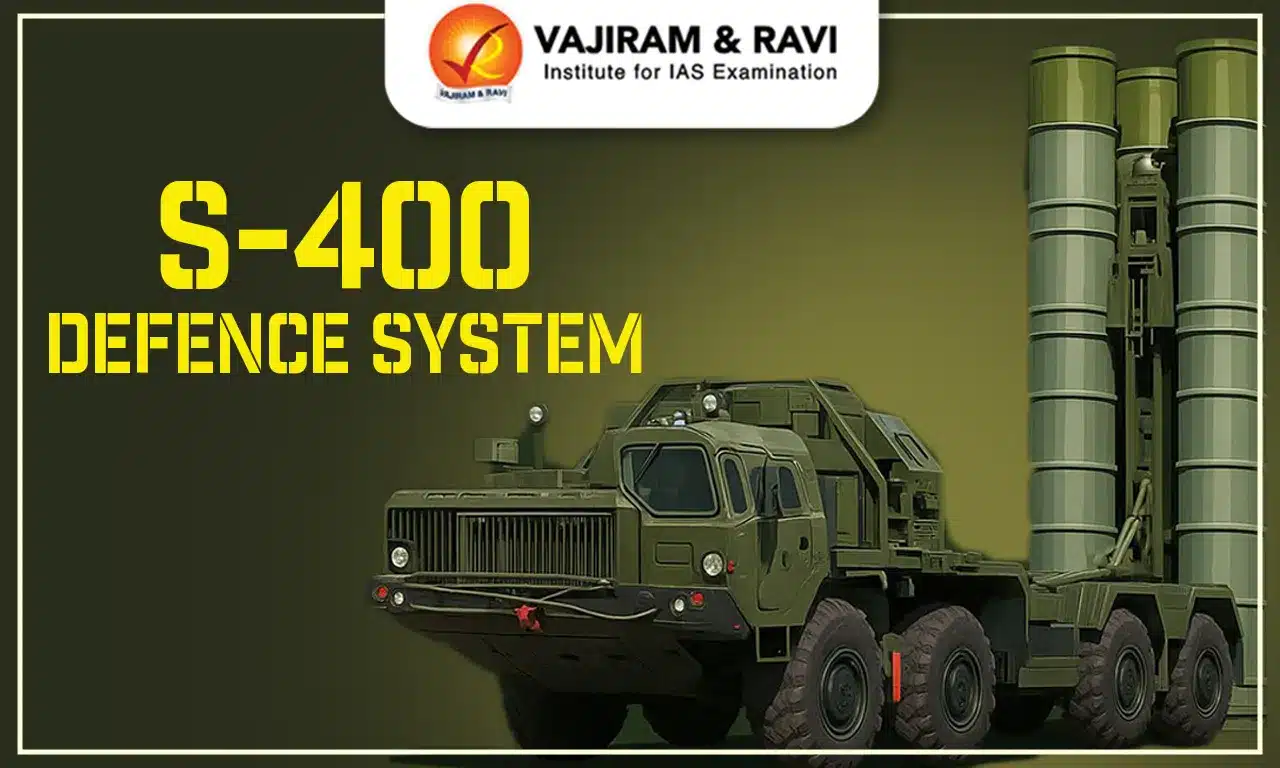Kalibangan is an ancient site of the Indus Valley Civilization, located on the banks of the Ghaggar River in the Hanumangarh district of Rajasthan. Kalibangan has emerged as an important site, offering valuable evidence about the Pre-Harappan and Harappan cultures that thrived in the region.
Kalibangan was the primary provincial capital of the Indus Valley Civilization. Kalibangan is known for its remarkable fire altars and the "world's earliest attested ploughed field."
About Kalibangan
The name Kalibangan is derived from two words: Kali and Bangan. Kali means black, and Bangan means bangle. Kalibangan was named after the myriad pieces of terracotta bangles excavated here.
- Location: It is located about 310 kilometres northwest of Delhi, along the left bank of the now-dry river Ghaggar in the Hanumangarh district of Rajasthan.
- Discovery: Luigi Pio Tessitori (1887-1919), an Italian Indologist, found the prehistoric site of Kalibangan.
- Former Archaeological Survey of India (ASI) director general Amranand Ghosh was the first to identify the site as Harappan and reported it for excavation.
- Balkrishna (B.K.) Thapar, M. D. Khare, K. M. Shrivastava, and S. P. Jain excavated the site for nine years (1960-1969) under the supervision of B. B. Lal (then Director General, ASI).
- Structure: Kalibangan consists of three mounds: the largest in the centre, the smallest in the west, and the smallest in the east. The excavations revealed the grid structure of a Harappan metropolis, which was probably 'the earliest city' of Indian cultural heritage.
- The most significant finding is the discovery of a pre-Harappan settlement beneath the remnants of the Harappan citadel.
- After Amri, Harappa, and Kot Diji, Kalibangan became the fourth site with archaeological evidence of pre-Harappan cultures.
- Kalibangan I (Pre-Harappan Phase): The pre-Harappan settlement was a fortified parallelogram surrounded by a mud-brick fortification wall. Evidence of the pre-Harappan period of Kalibangan, resembling Soti Siswal culture, was found in mound KLB-1.
- Single-story houses with mud walls and underground ovens resembling tandoors are found in the region. These homes had cylindrical pits lined with lime plaster, which may have been used to store drinking water.
- The remains of pottery were also found at sites near Soti, which belong to the Soti Siswar culture, an early Harappan culture.
- This Period's notable finds included small blades of chalcedony and agate, beads, bangles, and terracotta objects like a toy cart-wheel and a copper bull.
- Kalibangan II (Harappan): The Harappan period saw the settlement divided into two parts: the citadel on the west and the lower city on the east.
- The citadel was a fortified parallelogram with massive platforms and residential buildings.
- The lower city was also fortified, with streets arranged in a grid pattern. The lower city contained fire altars for ritual purposes.
- Chronology: The duration of the pre-harappan period is estimated at 2450–2300 B.C. Based on the evidence available, it is possible to infer that the Harappan period at Kalibangan began approximately 2300 B.C. and continued until 1750 B.C.
Archaeological Findings of Kalibangan
Kalibangan has provided an abundance of archaeological finds that shed light on the Indus Valley Civilization. Excavations at the site found a well-planned Harappan metropolis as well as traces of a pre-Harappan settlement. The significant archaeological findings are given below:
- Agricultural Development: Kalibangan excavation reveals ploughed fields with furrows intersecting at right angles, showcasing the evidence of multi-cropping. The site also shows evidence of manure and gypsum calcium sulphate being used as fertilisers.
- Archaeological evidence suggests that the earliest form of artificial irrigation was practised.
- Cattle were used for agricultural purposes as well.
- Social Inequalities: Symbolic burials at Kalibangan reveal information about the existence of social inequalities.
- An extended burial was probably used for an ordinary person.
- Urn burials are probably used by those from lower social strata, as they take up less space than an extended burial.
- Pot burial, which is a symbolic burial, involves an earthen pot with precious materials and other materials reflecting the belief in life after death.
- Trepanning was also noticed in a few instances.
- Trade: Mesopotamian pottery was discovered at Kalibangan, showing trade relations. Many semi-precious stones, such as Maulla, moonga, shells, and sometimes lapiz-lazuli, were found, reflecting that trading was a significant activity, as they were not naturally found in the region.
- Metallurgy: Kalibangan imported metals such as copper from Khetri mines in Rajasthan and chert from the Rohiri Hills in Pakistan. A copper bull showing the animal's dynamic mood and other copper objects, including a pin,were found.
- Terracotta: Terracotta objects like a toy cart, an incised terracotta cake, a terracotta human head, a terracotta feeding cup with a cow’s head on the rim, a terracotta graduated scale (incomplete) and an ivory comb; bangles of copper, shell, and terracotta are found.
- Seals: Most notable is a cylindrical seal depicting a female figure between two men fighting and threatening with spears.
- Fire Altars: The most important discovery of Kalibangan has been fire altars. A series of brick platforms were found, which were probably used for fire altars. On one of them, a row of seven 'fire altars' and a pit holding animal bones and antlers were discovered, providing evidence of animal sacrifice.
- Pottery: The potteryof this period was almost wheel-turnedand made of fine fabric. However, it was not as well-fired as Harappan pottery.
Kalibangan Significance
Kalibangan offers crucial insights into the Indus Valley Civilization's town planning, social structure, and agricultural practices. Notable archaeological findings include early evidence of cultivated fields, irrigation, and fire altars.
- Archaeological Evidence: Kalibangan is notable for its archaeological evidence of both the pre-Harappan period and the Harappan period. Kalibangan provides evidence of the fire altars and the practice of animal sacrifice.
- Urban Planning Insights: Kalibangan's layout and architecture provide a window into the urban planning of the Harappan era.
- Cultural Richness: Artifacts and structural remains offer a glimpse into the lifestyle, trade, and religious practices of the time.
- Agricultural Innovation: Kalibangan's evidence of ploughing and irrigation practices marks it as a pioneering site in ancient agricultural techniques.
- Surgical Knowledge: The discovery of trepanned skulls suggests an advanced understanding of human anatomy and early surgical practices.
- Social Hierarchy: The distinct urban sections, along with the varied burial practices, provide insights into the social structure, indicating a stratified society with complex social norms.
- Public and Private Spaces: The layout of public areas, such as marketplaces and ceremonial centres, alongside private residential spaces, illustrates the daily life and community interactions of the Harappan people.
Kalibangan UPSC PYQs
Question 1: Match List-I(Ancient site) with List II (Archaeological finding) and select the correct answer using the codes given below the lists: (UPSC Prelims 2002)
| List I (Ancient site) | List II (Archaeological Finding) | ||
| A | Lothal | 1 | Plough field |
| B | Kalibangan | 2 | Dockyard |
| C | Dholavira | 3 | Terracotta replica of a Plough |
| D | Banawali | 4 | An inscription comprising ten large-sized signs of the Harappan script |
(a) A-1; B-2; C-3; D-4
(b) A-2; B-1; C-4; D-3
(c) A-1; B-2; C-4; D-3
(d) A-2; B-1; C-3; D-4
Ans: (b)
| Other Related Posts | |
| Prehistoric Period | Indus Valley Civilization Sites |
| Chalcolithic Age | Rakhigarhi |
| Megalithic Culture | Lothal |
| Town Planning of Harappan Civilization | Kalibangan |
Last updated on December, 2025
→ Check out the latest UPSC Syllabus 2026 here.
→ Join Vajiram & Ravi’s Interview Guidance Programme for expert help to crack your final UPSC stage.
→ UPSC Mains Result 2025 is now out.
→ UPSC Notification 2026 is scheduled to be released on January 14, 2026.
→ UPSC Calendar 2026 is released on 15th May, 2025.
→ The UPSC Vacancy 2025 were released 1129, out of which 979 were for UPSC CSE and remaining 150 are for UPSC IFoS.
→ UPSC Prelims 2026 will be conducted on 24th May, 2026 & UPSC Mains 2026 will be conducted on 21st August 2026.
→ The UPSC Selection Process is of 3 stages-Prelims, Mains and Interview.
→ UPSC Result 2024 is released with latest UPSC Marksheet 2024. Check Now!
→ UPSC Prelims Result 2025 is out now for the CSE held on 25 May 2025.
→ UPSC Toppers List 2024 is released now. Shakti Dubey is UPSC AIR 1 2024 Topper.
→ UPSC Prelims Question Paper 2025 and Unofficial Prelims Answer Key 2025 are available now.
→ UPSC Mains Question Paper 2025 is out for Essay, GS 1, 2, 3 & GS 4.
→ UPSC Mains Indian Language Question Paper 2025 is now out.
→ UPSC Mains Optional Question Paper 2025 is now out.
→ Also check Best IAS Coaching in Delhi
Kalibangan FAQs
Q1. What was Kalibangan famous for?+
Q2. Who discovered Kalibangan in 1953?+
Q3. Where is the site of Kalibangan Harappan?+
Q4. What is the significance of Kalibanga?+
Q5. Why is Kalibangan known as black bangles?+
Tags: kalibangan quest

















